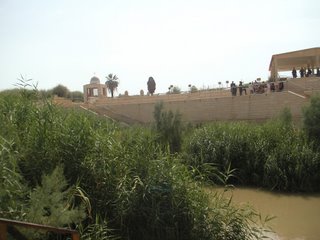 see from this picture taken at the legendary baptismal site of Jesus, the Jordan is no longer the rushing river of our Sunday school images. The flow is now 10% of its historical level and as it is the primary source of water to the Dead Sea the decrease is causing the Dead Sea to recede 3 feet per year. There is even a plan to build a canal from the Red Sea to the Dead Sea to refill it. As the Jordan River resource is depleted, Israel has become more and more dependent on the Eastern Aquifer on the West Bank for water resources not only for the settlements but also for Israel proper. Of the 46 MCM of water produced by Israeli wells inside the West Bank, 90% is used by the Israelis in the settlements and in Israel. Under Israeli law, Israelis are allowed to drill wells 250 ft deeper than Palestinians. This is conveniently enough to allow the Israelis to reach the aquifer, but not the Palestinians. The separation wall/fence is located so as to insure that access to the aquifer remains on the Israeli side of the barrier. None of this is sustainable by either side as the aquifer is being depleted at a rate higher than its recovery rate. This is a phenomenon familiar to those of us who live in the arid western U.S. Two maxims of the water conflicts in the west are “Water flows uphill towards money” and “Whiskey’s for drinking and water’s for fighting over”. They seem to apply in the Middle East as well.
see from this picture taken at the legendary baptismal site of Jesus, the Jordan is no longer the rushing river of our Sunday school images. The flow is now 10% of its historical level and as it is the primary source of water to the Dead Sea the decrease is causing the Dead Sea to recede 3 feet per year. There is even a plan to build a canal from the Red Sea to the Dead Sea to refill it. As the Jordan River resource is depleted, Israel has become more and more dependent on the Eastern Aquifer on the West Bank for water resources not only for the settlements but also for Israel proper. Of the 46 MCM of water produced by Israeli wells inside the West Bank, 90% is used by the Israelis in the settlements and in Israel. Under Israeli law, Israelis are allowed to drill wells 250 ft deeper than Palestinians. This is conveniently enough to allow the Israelis to reach the aquifer, but not the Palestinians. The separation wall/fence is located so as to insure that access to the aquifer remains on the Israeli side of the barrier. None of this is sustainable by either side as the aquifer is being depleted at a rate higher than its recovery rate. This is a phenomenon familiar to those of us who live in the arid western U.S. Two maxims of the water conflicts in the west are “Water flows uphill towards money” and “Whiskey’s for drinking and water’s for fighting over”. They seem to apply in the Middle East as well.Israel
Palestine
No comments:
Post a Comment